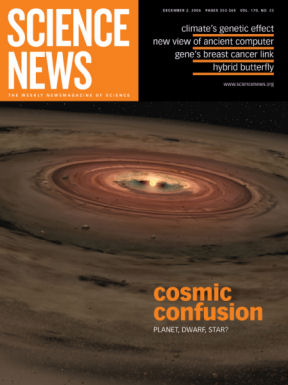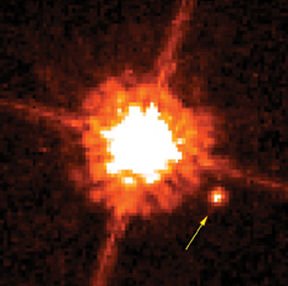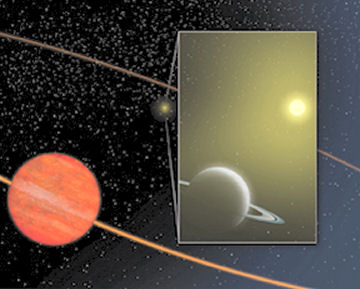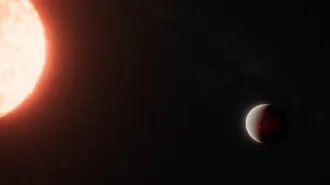“I found a planet!” Caltech astronomer Mike Brown remembers exclaiming during a phone call he made to his wife early in 2005. Little did he know that he’d have to eat his words just 18 months later. Brown had found an outer–solar system object heavier than Pluto, so it seemed reasonable to call the object the tenth planet.



But last August, the International Astronomical Union approved the first formal definition of a planet since the Greeks coined the term some 2,000 years ago. Pluto, got the boot, and Brown’s proposed tenth planet, a body now called Eris, was disqualified.
The group of astronomers decided to call Pluto and Eris “dwarf planets”—a class that the scientists say is separate from the solar system’s eight official planets. That decision remains controversial, although many astronomers say that there’s merit in the demotion. Both Pluto and Eris are considerably smaller than the first eight planets discovered. These two orbs ought to be grouped with the swarm of other icy objects in the Kuiper belt, a region beyond Neptune that may contain millions of such bodies, Brown says.
Although Pluto’s planethood is etched in cultural memory—and on lunch boxes, on postage stamps, and in textbooks—knowledge about the solar system has skyrocketed since the body’s discovery in 1930.
“The new definition essentially corrects an astronomical mistake from 76 years ago and shows that astronomy can move forward in the face of new information about the solar system,” Brown wrote recently on his blog (http://www.gps.caltech.edu/~mbrown/eightplanets/). But even as scientists and the public grapple with Pluto’s demotion, new findings from beyond the solar system are eroding the meaning of planet.
Over the past few years, astronomers have found several extrasolar objects that by weight would qualify as planets, yet they lack what would seem to be the most basic of planetary prerequisites—a parent star. Many of these free-floating orphans are surrounded by disks of dust and gas with enough mass to coalesce into their own miniature solar systems. One of the orphans, which some researchers call planemos, may even have a planetary-mass object orbiting it.
The discoveries are blurring the line between planets and stars—and may bring about a revolution in thinking about planets that goes far beyond the Pluto debate.
Old theories, new data
In the good old days, circa 1990, stars were stars and planets were planets. For the most part, astronomers accepted that stars arose from the gravitational collapse of giant clouds of gas. They shined by fusing hydrogen nuclei into heavier elements.
Planets, on the other hand, arose from disks of gas and dust surrounding stars. In the most popular theory, planets were spawned by bits of material in the disks gradually coalescing into larger and larger objects. In a competing scenario, sections of the disk suddenly fragmented, forming planets wholesale. In either case, planets orbited their parent stars and weren’t massive enough to trigger hydrogen fusion.
But in the early 1990s, researchers discovered the first hybrid objects—failed stars known as brown dwarfs. These bodies, theorized to form as stars do, tip the scales at up to 75 times the mass of Jupiter, the most massive planet in the solar system.
Although the minimum mass of a brown dwarf remains controversial, some researchers peg it at 13 Jupiter masses. That’s hefty enough to initiate fusion but not to sustain it. After these failed stars stop that process, they spend the remainder of eternity cooling.
The discovery of planets that orbit sunlike stars further muddied the standard picture of planet formation. For starters, many of these extrasolar planets are several times as heavy as Jupiter. Also, around the time of the discovery of these massive orbs, several researchers, including Gibor Basri of the University of California, Berkeley, were finding dwarfs with lower and lower masses. Inevitably, note Basri and Brown in the 2006 Annual Review of Earth and Planetary Science, extrasolar planets and brown dwarfs became harder to tell apart. About 5 years ago, astronomers began finding objects in Jupiter’s mass range that weren’t orbiting anything (SN: 5/19/01, p. 312: Available to subscribers at Free-floaters: Images of planets?).
“Astronomers and planetary scientists were forced to admit that they didn’t really have a clear-cut definition of ‘planet,'” Basri and Brown say.
Puzzling findings
“The fact is there is ambiguity … and this ambiguity will be with us for a while,” says theorist Adam Burrows of the University of Arizona in Tucson.
Consider, for instance, the star HD 3651, which is slightly less massive than the sun and just 36 light-years from Earth. By measuring the back-and-forth motion of this star, astronomers deduced several years ago that HD 3651 hosts a planet smaller than Saturn that whips around the star in a close, 62-day orbit. Now astronomers have directly imaged a much more distant object orbiting HD 3651. The new find is one of the faintest and coolest brown dwarfs ever discovered close to Earth. The object lies about 1,500 times farther from HD 3651 than the star’s planet does.
The image of HD 3651 demonstrates for the first time that brown dwarfs and planets can form around the same star—perhaps in the same way—notes Markus Mugrauer of the University of Jena in Germany. He and his colleagues describe their findings, from several ground-based telescopes, in the November Monthly Notices of the Royal Astronomical Society: Letters. Another team, led by Kevin Luhman of Penn State University in State College and using NASA’s orbiting Spitzer Space Telescope, describes its study of HD 3651 in the Jan. 1, 2007 Astrophysical Journal.
In separate work, reported in the Oct. 1 Astrophysical Journal, Luhman and his colleagues used the Hubble Space Telescope to photograph an object, about 10 Jupiter masses, orbiting the star CHXR 73. The orbiting object’s mass alone would typically identify it as a heavy planet spawned from a disk that once surrounded this young star.
However, the newfound object lies about five times as far from CHXR 73 as Pluto’s average distance from the sun. Theory suggests that a gas-and-dust disk isn’t likely to contain enough material that far from a star to make a planet. “Although the object seems to be [of] planetary mass, we argue that it’s not a planetary companion, just a very small brown dwarf companion,” says Luhman.
Distinguishing between brown dwarfs and planets is important, says Luhman. A brown dwarf could have its own retinue of planets, which astronomers could search for. In contrast, a planet at such a great distance from its parent star would most likely be a loner.
In a report presented in August at the meeting of the International Astronomical Union in Prague, researchers suggested that brown dwarfs might form in a different manner from both stars and planets. According to the new hypothesis, brown dwarfs are much smaller than bona fide stars because a dwarf arises from the sudden fragmentation of a ring or disk of material surrounding a pair of brand new stars.
Planets might also arise in this manner, but the fragmentation of a large disk surrounding two stars favors the formation of a brown dwarf, according to study coauthor Greg Laughlin of the University of California, Santa Cruz.
In many cases, the stellar pair kicks away the new dwarf but doesn’t give the body enough oomph to escape a surrounding cluster of stars. That would account for the multitude of brown dwarf loners found in young stellar clusters, such as the Orion star-forming region. In other cases, the dwarf remains in orbit around the two stars. Laughlin, Doug Lin, also at Santa Cruz, and Ing-Guey Jiang of the Central University of Taiwan recently posted their ideas online (http://xxx.lanl.gov/abs/astro-ph/0610814).
It might be that planet formation proceeds at different rates and in different ways at different distances from stars, says extrasolar-planet hunter Ray Jayawardhana of the University of Toronto. Moreover, determining just how little mass an object can have and still qualify as a star provides critical information about the history of star formation throughout the universe.
Riddle resolutions
Given the shifting definition of stars and planets, what are astronomers to do?
Basri and Brown each suggests a different way out of the planetary puzzle. Basri proposes lumping together all objects massive enough to have ever undergone nuclear fusion—whether they did so for less than a million years as a brown dwarf or billions of years as a sunlike star. He would call all such objects fusors, which he maintains are fundamentally different from objects that never had enough mass to fuse nuclei.
Basri would call the lower-mass objects planemos. Only those planemos that orbit a fusor would be considered planets.
Brown, Luhman, and some other astronomers prefer to categorize objects on the basis of how they formed, not how big they are. A low-mass object would qualify as a planet only if it formed from a gas-and-dust disk surrounding a star, even a brown dwarf.
There’s a hint that nature itself distinguishes objects on the basis of how they form, Brown says. The universe appears to have separate methods and locations for forming star companions, depending on their mass. Within the immediate neighborhood of a star—a few times the Earth-sun distance—orbiting objects tend to be either less than five or more than 60 times Jupiter’s mass.
The gap in mass suggests that nature has two distinct ways to make an object that will orbit a star, Jayawardhana notes. One mechanism, the traditional planet-formation scenario, may dominate at low masses, while another, which tends to make brown dwarfs, may dominate at high masses.
Determining how an object formed, however, is a daunting task, notes Luhman. Telescopes take snapshots but not movies following a body back in time to its origin.
Using the proposed successor to Hubble, the James Webb Space Telescope, as well as sharpened optics soon to be installed on the ground-based Gemini North and South telescopes, astronomers hope to determine whether planets exist farther away from stars’ neighborhoods. This may provide additional clues about planet formation. The sharper resolution will also give astronomers a chance to directly glimpse extrasolar planets like those in our own solar system.
“At some level, I don’t’ really care” what people call planets and stars, says Jayawardhana. “To me, the main sort of motivation and fascination with this business … is that we’ve learned in the last couple of years that nature seems to be able to make planetary-mass objects in more than one way.” He adds, “We haven’t figured out details of the story, but it’s saying something really fundamental” about the universe.
For now, Burrows suggests that astronomers hold back on a rigid definition of planet. “People just want … to name things or to stuff objects into cubbyholes,” he says. “I prefer a bit of ambiguity to the illusion of clarity and the pretense of certainty. When there is fog, to acknowledge its presence is more honest than to try to ignore it.”







